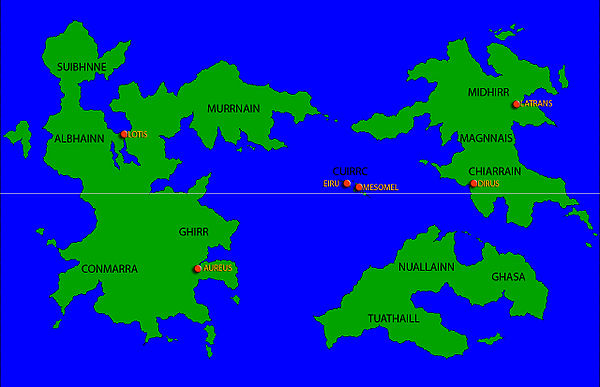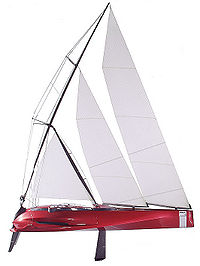| |||||||||||||||||||||||||||||||||||||||||||||
Contents
System
The Cyon system is nestled between the Plosa Nebula and the Rigor Strand, making it a mildly popular fueling stop for traders travelling through the Daucon Corridor to access the Shard or Ulsha systems. It has four planets and three asteroid belts.
Sun
Cyon is a mid-range G-type white star. There is evidence that it was once a binary star, but managed to absorb its sister billions of years ago without going nova. It is likely that the resulting reaction destroyed at least two planets in close orbit, creating the Maolainn belt.
Planets
The Cyon system has four planets: Pyracan, Chyurus, Austral, and Calopex. Pyracan and Chyurus are rocky, while Austral and Calopex are both gas giants.
Moons
Pyracan has two moons, Adust and Cana. Adust is large and dusty pink, and Cana is a small but extremely reflective bluish-brown, and revolves around Adust.
Other Phenomena
The Cyon system has three asteroid belts, with two placed between Pyracan and Cyon, and one between Pyracan and Chyurus. In increasing distance from Cyon, they are the Maolainn belt, the Ghamha belt, and the Loideainn belt.
History
For a more in-depth history, see Pyracan Timeline.
Ancient History
- 694 CE - The Supreme One speaks to the Holy Daughter Zoru Ruannaigh in Dirus, laying out his Path for the Pyracani.
- 1867 CE - The War of the Two Reighainns begins in Aureus over a blood feud between cousins.
- 1874 CE - The War of the Two Reighainns ends, having claimed over thirty thousand Pyracani, including the entire Murrnainn royal family.
Modern History
- 1938 CE - Bonding Day. Wurr Dourragh successfully unifies the Twelve Nations under a single government, and instills the Church of the Supreme One as the official religion, banning the worship of false gods.
- 2340 CE - Pyracan is ‘discovered’ by a Hekayti probe occupied by the body of Hiver war heroine Einkap Astr Angbarskfruktledelkrig. A manned scout is sent soon after with an exploratory party.
- 2346 CE – The Fyirrik's Affront. A major rift in the church of the Supreme One begins in the holy city of Dirus after a Hiver bomb blows up their newly-built spaceport in Aureus, killing over a thousand Pyracani and throwing the planet into panic. A large group of senior priests, led by High Confessor Prut Currin, declare that the beings beyond the moons are subjects of a much more complex and multifaceted Supreme One than was previously known. This flies in the face of the High Bishops’ ruling in 2341 that beings beyond Pyracan are direct agents of the Supreme One, and their actions mirror the Supreme One’s will for the Pyracani.
- 2347 CE – High Confessor Prut Currin defeats all five High Bishops in one-on-one combat, and installs five new High Bishops, in an event later called the Purple Dawn.
Hiver War
- 2347 CE - Late in the year, the Grand Council formally declares war on the Hivers, despite owning only three small, armed FTL-capable ships.
- 2348 CE – The Pyracani make a pact with the Falari to serve as ground troops in the Falari space navy, and serve with honor for more than 300 years, leaving a ceremonial force with the Falari even after they’ve developed their own space navy.
- 2642 CE - Zaluan Liberation - The slave colony of Zaluan is liberated by a mix of Hekayti, Falari and Pyracani forces, freeing over fifty thousand sentients.
- 2646 CE - Battle of Juval Cluster - In the Juval Cluster, in the galactic eastern end of Hekayti territory, a Pyracani picket ship discovers a Thul shipyard with almost two dozen active warships. Seven Pyracan frigates hold off the fleet for three days with guerilla tactics until Hekayti and Lyiri forces are able to arrive.
- 2648 CE - Battle of Glornish Station - Hekayti forces blockade a Thul supply depot just galactic west of the Cyon system for over a month with no visible effect, until it is determined that teleportation rods are being used to run the blockade. Pyracan fighters are used to distract Glornish Station's mission control while Pyracani marines storm the station. Unfortunately, it appears that the Thul also teleported in a large number of troops, and the Pyracani suffer heavy casualties before taking the station.
- 2649 CE - Battle of Blue Sands - At the galactic northwest edge of the Daucon Corridor in an asteroid field called Blue Sands, Pyracan forces engage the Hiver-controlled Pyracan destroyer MCV Huaina. When the destroyer MCV Likos' reactor is breached, Captain Roor Morrdha makes the fateful decision to ram it into the Huaina in order to recover the souls of the Hiver-possessed Pyracani within for the Supreme One. All hands aboard both destroyers are incinerated in the resulting blast.
Post-Hiver War
- March, 2653 CE - Pyracan accepts around 3000 Riftwalkers found floating in the Cyon System as refugees.
- May, 2653 CE - Pyracan accepts a little over 4000 refugees when the Nall briefly take over Comorro Station.
- May, 2653 CE - Ground breaks on the Outverser settlement of Eiru.
Geography
Continents
Pyracan has three main continents.
Cities of Note
- Aureus - The capital of Pyracan since the Bonding in 1938 united the twelve nations, it is occupied by over eight million sapients. Almost all of the planet's technical or industrial jobs are found in Aureus and its immediate suburbs, and four of the six universities that teach a 'modern' education are found here. Frequently demonized by the country folk as sinful and overly liberal, this is likely due to it housing the vast majority of the offworlders on Pyracan.
- Dirus - Pyracan's most populous (and largest) city, housing over twelve million in a sprawl that stretches for fifty miles. It draws religious pilgrims several times a year due to being the city where the Supreme One laid out the Path to his followers. On its outskirts is Laobhe Academy, the premier military school on Pyracan.
- Eiru - An outverser settlement created in 2653, it is on the northeastern shore of an 1850 square mile island in the tropics, near Mesomel.
- Latrans - Once a large village centered around a gigantic artisan monastery on a hill, offworld developers began to build hotels and other attractions to attract tourists in the early 2500's. During the 2500's, it was a well-known tourist trap, and locals were hired to act like outworlder expectations, playing the noble savage to a tee. As Pyracani began to permeate into the Ancient Expanse, they became less of a fad, and the tourism trade collapsed. Now, the city has a mere five hundred thousand citizens, and has since re-appropriated many of the abandoned modern buildings for their own use.
- Lotis – A temperate village of forty-five thousand, it sits between the four long, thin lakes known as the Marks and the Eoghainn sea. It is known for having one of the two modern universities on Pyracan outside of Aureus, and for its monestary that hand-crafts energy weapons.
- Milium - A suburb of Lotis known for its large, expensive estates and high Muscipulan population.
- Mesomel - A subtropical beach community of eighty-five thousand, popular with Ancient Expanse surfers and anglers for its large fish and larger waves. It houses a monestary, Tarrpaigh, which is the sole source of the light green liquor of the same name.
Major Oceans
Major Rivers
Climate
In general, it is a mild and moist planet, with abundant greenery and a relatively small polar cap. Temperatures change very little from season to season in most populated areas.
Biology
Flora
Fauna
Geology
Orbital Period:
Radius:
Day Length:
Atmospheric Pressure:
Surface Temperature:
Surface Gravity:
Minerals
Society
Language
The primary spoken and written language of Pyracan is Canii, closely followed by Hekayan.
Government
Grand Council
Pyracan is governed by the Grand Council, which in turn appoints an Alpha to oversee the government. The Council consists of elected representatives from the 12 nations of the Pyracani, who are in turn formed from hundreds of tribes. The Council meets once a month to decide on issues facing the society as a whole, and sometimes more frequently if there are pressing issues, or if the world is at war. The Alpha is referred to as 'Excellency' or simply 'Alpha', while the Grand Council members are referred to as 'Councillor'.
Law among the Pyracani is often administered through the individual nations, with the Grand Council serving a dual role as a Supreme Court if a nation is unable to decide a case internally. This is rare, but in the cases where it has happened, the Council’s decision is final.
Church of the Supreme One
The main church of Pyracan serves in a quasi-governmental role in adjudicating some disputes and has its own small standing army, though there have been recent governmental inquiries into its necessity.
The Twelve Nations
Each of the twelve nations has its own laws and customs, and typically handles its own affairs so long as it’s not a multi-nation or offworlder issue. They are as follows:
- Albhainn – City of Lotis.
- Chiarrain – City of Dirus.
- Conmarra - The birthplace of the Rickirr.
- Cuirrc – City-state of Mesomel.
- Ghasa
- Ghirr – Capital of Aureus, and the seat of the Grand Council.
- Magnnais
- Midhirr – City of Latrans, and the birthplace of the Satai.
- Murrnain
- Nuallainn – Extremely dry, it is the home nation of the Nuall subrace, a five foot tall, sandy-furred people with narrow snouts, slight builds and very large ears.
- Suibhnne
- Tuathaill
Military
Economy
Infrastructure
Industry
The Pyracani have an extremely rich tradition of artisanal crafting, eschewing modern methods and mechanization wherever possible. Many have a belief that the Supreme One can be introduced to non-living materials through thoughtful and purposeful crafting, and thus the act of creating is a religious act. They have formed this into a niche market for gourmet and luxury goods, and do quite well for themselves.
Agriculture
Agriculture and aquaculture are major industries of Pyracan, though they have nowhere near the output of Muscipulans or the efficiency of the Hekayti.
They are well-known for their domesticated animals, producing some of the finest meat, milk and fur in the Ancient Expanse.
Natural Resources
Education
Pyracan houses eleven public universities and almost fifty private ones, but only six of these address modern subjects such as engineering, astronomy, piloting, manufacturing, nano/genetic medicine, and Hiverspace history. This is a list of the more notable schools.
- University of Ghirr – The largest university on Pyracan and one of the six ‘modern’ universities, it is known for its law and political science curricula. It is located in Aureus.
- Gabhainn University – A prestigious private university in Lotis and one of the six ‘modern’ universities, it is known for its engineering, journalism and domesticated animal and plant genetics curricula.
- Seannain College – Focused solely on Liberal Arts subjects like history, psychology, philosophy, theology and anthropology, this private college is one of the six ‘modern’ universities, and located in Aureus.
- Raghlagh University –
- Laobhe Academy – The most prestigious military academy on Pyracan, just outside of Dirus.
- University of Tuathaill - A prestigious art college with a wide variety of advanced craft studies.
- Midhirr College - Known for its outstanding metalworkers, whether in fine jewelry, blacksmithing, cermet blends, or like its most famous modern graduate, handmade ship parts.
Religion
Rites of Passage
Entertainment
Theater
Truthseeker Play - A very stylized dramatic play in five parts, having survived for over a thousand years. It features exaggerated movements, extreme facial expressions, loud, overly-emotional dialogue and elaborate costumes. Each play must include an introduction to characters in the first part, a battle in the second and fourth parts, a revelation, tragedy or moment of high drama in the third part, and a swift resolution in the fifth part that sets everything right. They include at least one song in which the protagonist plays an instrument that they crafted themselves. This has been stretched in the last two hundred years to include things like percussion on personally-crafted armor or the whistling of a swung sword. Popular Truthseeker actors and actresses enjoy high celebrity on Pyracan.
Sports
Satailarr - An extremely popular Pyracan sport, and extremely old. The objective is to break all 21 of the other team's long, wooden stakes with a stiff leather disc before they break all of yours without your body touching either the ground or the stakes.
Tuinne - Simply, racing sail yachts across the ocean. Several contests are set up throughout the year, with elaborate trophies and ceremonies for the winners. As boating is an extremely popular recreational sport on Pyracan, quite a few Pyracani keep up with these races.
Fiction
A Mythological Journey - The classic author Urr penned several popular original texts in the 2020's and 30's, but none so famous as A Mythological Journey, a compilation of hundreds of old stories about ancient Pyracani and the old spirits, translated into Canii and set to verse. As the last known follower of the old spirits died in 2078, A Mythological Journey quickly became the definitive work on the subject, and by the current day remains nearly the only source of information on the spirits.
Games
Titimbolg - A dangerous game played by teens near equatorial beaches, it involves the collection of four or more wild bolgs per person, tying their hydrogen valves closed and weaving a crude hammock connecting them. A teen sits in this hammock, and the lighter-than-air bolgs pull him into the air, often at heights greater than a hundred feet. Whoever is able to 'drive' their bolgs either the longest or the furthest (depending on the version of the game) before touching the ground is considered the winner.
Music
Smoke Dirge - Originally derived from the complex funereal howls of the Fire's Return, it is a choral style that features four or six part harmonies, breathing techniques that make it seem as if the singers never take a breath, and most often a melancholy theme. It has been described as ghostly, operatic, thoughtful and haunting by its followers, and like the warbling of meirle by its detractors. Smoke dirges are a popular part of the third act of many Truthseeker plays.
Visual Arts
Greimithir - In prehistoric times, 'killing bite' art was popular on the western continent for thousands of years. This entailed the 'painter' chasing his prey into a dry cave then delivering the takedown bite, wrestling with the prey until it was dead. The resulting spatter and energetic smears of blood and innards were meant to show others just how strong and virile both the hunted and hunter were. In 2593, the postnaturist artist Birk Baegymm began replicating this art, calling it Greimithir. He chose symbolic subjects of the killing bite, such as computer terminals, hoverboards, and famously, an interstellar shuttle, and tore them apart using only his teeth, hands and feet. This last act caused him to be hospitalized for over two months due to polydenum poisoning. Artists continue this trend even today, taking out their aggressions against the modern world and even expanding into the conquering of intangible subjects like love and greed.
Miscellaneous
Demographics
On Pyracan, 46% of Pyracani are male and 54% are female. The average age is 56, and the average age at death is 130. Approximately 2% of the population is disabled in some fashion. Average income is slightly below average in the Ancient Expanse. The average Pyracani has completed fifteen years of education, and has an associate’s degree. 83% own their own home, and there is an unemployment rate of 9%. Nearly 85% of Pyracani self-identify as mixed-race. The only significant race is the Nuall, a small, slight group with short hair, long, thin muzzles and large ears. They isolate themselves in small tribes in the deserts of Nuallainn, and do not pay taxes or otherwise engage in government or politics.
Pyracan features a significant number of Falari, Muscipulans and Hekayti, with a small number of outverser immigrants. The Falari and Hekayti populations mainly stick to the city of Aureus and a few tourist areas, while the Muscipulans have been grabbing up rural land over the last hundred years and making estates and hobby farms. While the Falari are widely accepted as noble (if overly technical and modern) allies in the Hiver War, the Hekayti and Muscipulan populations elicit a wide variety of reactions. The general stereotypes of the Hekayti on Pyracan are as a stable, level-headed big brother, as the heroes who helped Pyracan into a brand new age, as a noble race that understands honor in combat, as a meddling Empire that looks down on other races, and as a jaded people with such a hard heart and long memory that they’re unwilling to give people a chance. Stereotypes of Muscipulans are as hardworking crafters of money, as special creatures free of the influences of one’s base animal nature, as ageless sages who have seen it all and can impart a timeless wisdom, as crafty political types who follow the letter of the law instead of the intent, as trying to take over Pyracan covertly via land buys and influencing the Grand Council, and as a spineless race unwilling to stand up for any beliefs.


